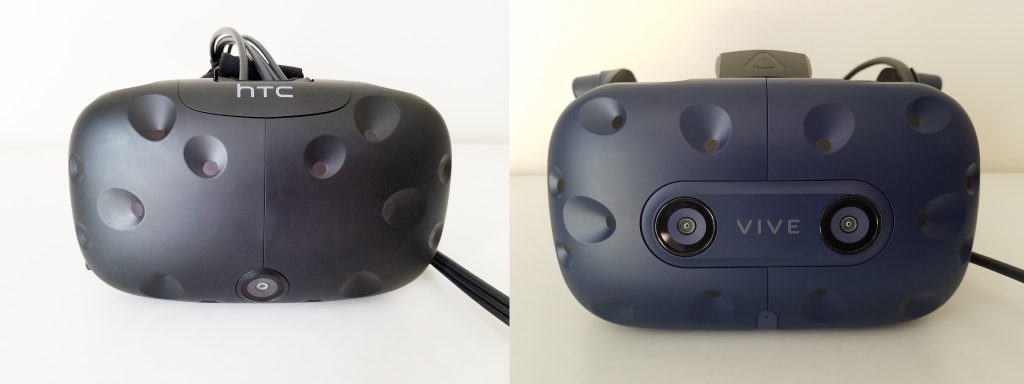I’ve owned a Vive since it first launched back in 2016 and it got me so hooked on VR that I also went out and bought an Oculus Rift. Both the Rift and the Vive are fantastic headsets, each with their own advantages, but with very similar specs. The Oculus and Vive both feature a resolution of 1080 x 1200 pixels per eye (2160 x 1200 pixels combined), with a field of view of 110°, and a refresh rate of 90hz. The next generation is here with the Vive Pro from HTC and the much anticipated Santa Cruz HMD from Oculus is on the horizon. After spending hundreds of hours in the classic Vive, I was eager to see how the Vive Pro improves the VR experience.

Display
The refresh rate and field of view are the same so the experience is still very smooth, but it does still feel like you’re looking at a world through goggles. The headset lenses still use the fresnel design from the original Vive, so you’ll still see slight auras around brighter objects, but it’s subtle and has never bothered me.
The upgrade in resolution is very noticeable, however it’s not night and day. The headset isn’t suddenly pushing anything crazy like 4k, but the Vive Pro does have a combined resolution of 2880 x 1600, which is a decent bump over the classic Vive’s 2160 x 1200. I’m able to see a lot more detail in 360° videos and when playing games everything feels much crisper. The bump in the resolution doesn’t fix all the current problems with VR though. The “screen door” effect isn’t nearly as noticeable as it is in the classic Vive, but it’s still there and people or objects in the distance will still appear a bit blurry.
Audio
The classic Vive came with earbuds, or you could use your own headphones. The Vive Pro comes setup with a strap that feels very similar to the Vive’s “Deluxe Audio Strap” with built in headphones and an addition of an in-line amplifier. The built in headphones sound decent, albiet a tad hollow at times. With the way HTC was building up the headphones prior to the release, I did expect a bit more, but they serve their purpose. Personally, I will continue using the built in headphones because they’re much more convenient and feel pretty on par with what I’m used to with the Oculus Rift.
Microphone
The original Vive has a built in microphone that sounds surprisingly good, but the Vive Pro features dual mics. After recording myself talking on both headsets, I found the audio quality to be very similar. The original Vive already has a great sounding microphone that delivers clear voice and eliminates background noise quite well. The Vive Pro offers improved noise reduction and comparable voice clairty. Another great feature of the dual mics is that they activate when I want to see the outside world through the front facing cameras on the headset. This means I don’t have to take the headphones off as I can hear everything the microphones pick up.
Comfort
One thing I do not enjoy about the classic Vive is how uncomfortable it can be. The Rift is light and easy to put on, but the classic Vive is front-heavy and the straps make it awkward to put on and adjust. The Vive Pro is far more comfortable to wear. The weight is much better distributed and it not longer feels like the bridge of my nose is supporting the weight of the entire headset. The ability to tighten and loosen the headset with a twist knob is a huge convenience and time-saver as well.
Having the single cord coming out the back of the Pro is a plus because, let’s face it, VR feels awkward enough as is. The fewer wires the better. HTC claims there will soon be a wireless adapter available as an additional purchase for the Vive Pro.
Is It Worth It?
The Vive Pro certainly doesn’t revolutionize VR, but it does improve on the Vive in almost every way, even if the improvements are minor. The Vive Pro retails for $800…and that doesn’t include the controllers and required tracking stations, which will set you back a few more hundred if you don’t have these items from the classic Vive. With the improved visuals, built in headphones, and much improved comfort, the Vive Pro does feel like it’s currently the best headset on the market, headsets like the Samsung Odyssey offering the same resolution bump at half the price make the Vive Pro hard to fully endorse.
Ultimately, the Vive Pro is great. It feels like what the Vive should have been at launch. But if you’re like me and don’t own a swimming pool filled with money, I’d say the Pro isn’t really worth the large price tag.
It’s exciting to see how things continue to move forward with VR. Pimax successfully kickstarted an 8k headset that I’m eager to try, and we still have the wireless Oculus Santa Cruz HMD in the future. The Vive Pro may be a bit of a steep price, but the price drop for the classic Vive makes now a better time than ever to give VR a go if your computer can power it.


